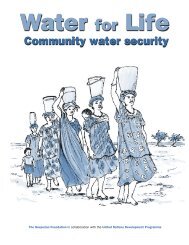A Sourcebook - UN-Water
A Sourcebook - UN-Water
A Sourcebook - UN-Water
You also want an ePaper? Increase the reach of your titles
YUMPU automatically turns print PDFs into web optimized ePapers that Google loves.
technology in selected areas”, but what to do if very few staff in the utility, or indeed in the country as<br />
a whole, have any familiarity with modern technology?<br />
This section illustrates how the approaches set out in the earlier section can be applied in various country<br />
circumstances. Section 11.1 discusses application in various sector structures. Section 11.2 discusses<br />
“second best” options, focusing on what to do when limited political will or administrative capacity<br />
constrain what is possible. Finally, Section 11.3 recognizes the difficulty of prioritizing reforms when resources<br />
are limited and the number of con-currant activities is necessarily constrained, and provides<br />
approached for “packaging” governance interventions into manageable programs or phases.<br />
This section attempts to illustrate how “best practice” advice can be modified to work in less than optimal<br />
situations. That is, it discusses “second best” options for use in contexts where administrative capacity<br />
or political will make first best options impractical.<br />
This section then goes on to discuss “packaging” governance interventions into manageable programs<br />
or phases that tackle high-priority areas first, and aim to establish a “pro-probity” dynamic.<br />
11.1 Adapting to Sector Structures<br />
The preceding sections often assume a centralized sector structure in which a publicly-owned, national<br />
water provider is controlled by a Ministry in the central Government. This section discusses how<br />
the basic ideas can be adapted in applied in more decentralized sectors, with a variety of forms of<br />
provider ownership and management. In many cases, the guidance in Sections 8 and 9 can be directly<br />
adopted for a decentralized sector, with merely a substitution of actors (for example, “mayor”<br />
substituted for “Minister”). However, in other cases, a different sector structure may lead practitioners<br />
to a different approach to improving governance.<br />
11.1.1 Centralized and decentralized sector structures<br />
<strong>Water</strong> sector structures vary widely between countries. Many countries—for example Colombia, the<br />
Philippines, and France—have long established traditions of local government responsibility for water<br />
services. Other countries previously had a national water provider—generally a government department<br />
or statutory corporation—but moved to decentralized water provision during the 1990s, when<br />
government decentralization became popular. Some federal countries have state-level water providers,<br />
or a mix of state and municipal responsibilities, as in India and Brazil.<br />
Varying allocations for government responsibility for water create varying governance challenges and<br />
opportunities. Some general points to consider include:<br />
• L ocal government responsibility for water services can have the advantage of increased accountability<br />
of the government body responsible to the citizens served. The “route of accountability”<br />
from consumers to local government and local providers is more direct than that from<br />
consumers to central government. But an important disadvantage of local provision, from a<br />
governance point of view, is that local governments, and small local providers, often have<br />
lower capacity than higher levels of government and large providers. As a result they may be<br />
less well able to plan, to put in place proper systems<br />
N ational government responsibility for water services<br />
• , conversely, may in many cases connote<br />
greater competence, and an ability to achieve coordination and economies of scale.<br />
A governance benefit of centralized provision may be the ability to conserve scarce human<br />
resources such as skilled technicians, managers, and planners, concentrating them in a single<br />
agency. However, this comes at the cost of diffused accountability. <strong>Water</strong> service provision,<br />
especially in secondary towns, will seldom be a national election issue, so one of the most<br />
124
















